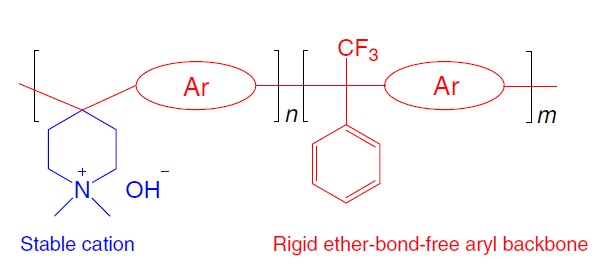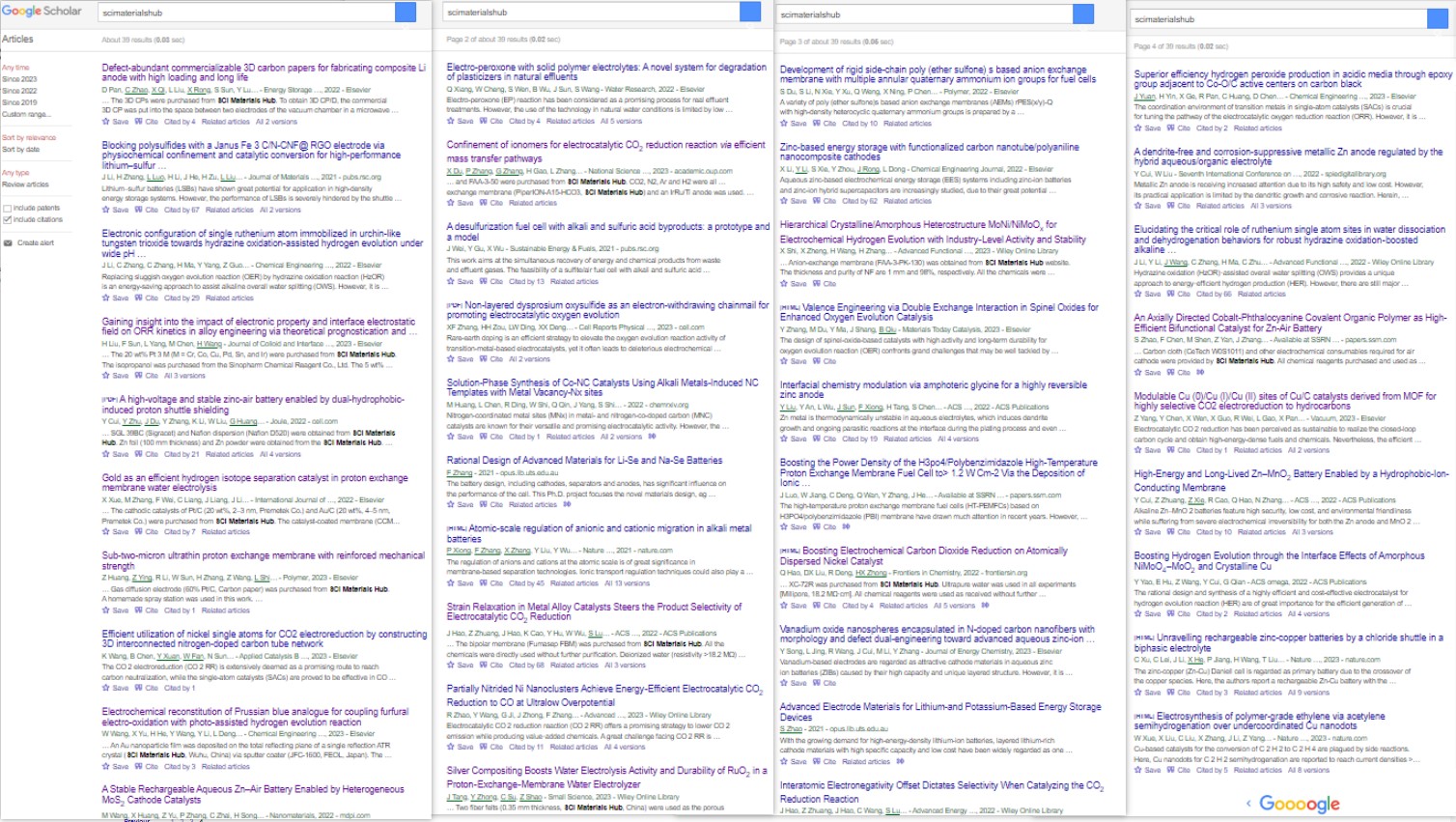
PiperION-A70-HCO3 70 micrometers thick self-supporting anion exchange membrane sheets.
PiperION self-supporting AEMs are manufactured solely from the functionalized poly(aryl piperidinium) resin material and there is no mechanical reinforcement in them. Having the entire membrane manufactured from 100% resin material makes this membrane category to have higher ionic conductivity compared to mechanically reinforced PiperION AEM counterparts. In terms of mechanical robustness, mechanically reinforced PiperION AEMs would provide higher performance compared to self-supporting PiperION AEM counterparts.
PiperION AEMs are manufactured from the functionalized poly(aryl piperidinium) polymer. The general chemical structure of the poly(aryl piperidinium) resin material is provided below.

Benefits of Self-Supporting PiperION AEMs:
-Non-reinforced and high anionic conductivity
-Excellent chemical stability in caustic and acidic environments (pH range of 1-14)
-Ultra-thin membranes with superb performance for various alkaline fuel cell, alkaline electrolyzer, direct ammonia fuel cells, and other relevant electrochemical technologies
| Thickness (micrometers) | Tensile Strength (MPa) | Young's Modulus | Elongation at Break (%) | EC (meq/g) | Conductivity (mS/cm, OH-, 80 °C) |
| 20 | >30 | >30 | >20 | ~2.35 | ~150 |
| 80 | >50 | >50 | >100 | ~2.35 | ~150 |
*Some of the important properties of PiperION membranes are provided in the table are for reference and example purposes only.
PiperION membranes are shipped in the non-hydroxide form (more specifically in the bicarbonate form) and the proper pretreatment protocol needs to be followed in order to convert it to the desired anionic form.
Allow the membrane to sit at ambient conditions for 1 hr without a cover sheet before use.
For hydroxide exchange membrane fuel cell or hydroxide exchange electrolysis applications or any other application that requires the hydroxide ion transfer across the membrane, the membrane should be converted from bicarbonate form into OH- form for optimal conductivity.
To convert the membrane to OH- form, place the membrane in an aqueous solution of 0.5 M NaOH or KOH for 1 h at room temperature. After 1 h, replace the solution with fresh 0.5 M NaOH or KOH and allow the membrane to soak for 1 h at room temperature again. After the two soaks, rinse the membrane with DI water (pH ~ 7). Minimize exposure to ambient air, as the CO2 can exchange back into the membrane causing the membrane to convert back to bicarbonate form. The reaction between CO2 and hydroxide ions is purely chemical and it will readily happen if the OH- form of the membrane is exposed to an environment that has CO2 (such as ambient air, etc.). This conversion can be completely eliminated by simply doing the conversion and testing in a CO2-free drybox environment.
Allow the membrane to sit at ambient conditions for 1 hr without a cover sheet before use.
The PiperION membrane is shipped in the bicarbonate form. If you are working with bicarbonate electrolytes in your setup, then there is no need to pretreat the membrane and it can be used in the as received form.
If you are working with carbonate electrolytes, then the PiperIon membrane needs to be converted to carbonate form. In order to achieve this, simply submerge the membrane in an aqueous solution of 0.1 - 0.5 M sodium carbonate or potassium carbonate for 12 h at room temperature. After then, replace the solution with fresh 0.1 - 0.5 M sodium carbonate or potassium carbonate and allow the membrane to soak for 12 h at room temperature again. After the two-three soaks, rinse the membrane with DI water (pH ~ 7).
Instead of bicarbonate or carbonate electrolytes, if you are using KOH or NaOH type pure alkaline electrolytes in your CO2 reduction experiments, then you can simply follow the "For standard alkaline fuel cell / electrolysis applications" protocol for converting the membrane to OH- form.
Allow the membrane to sit at ambient conditions for 1 hr without a cover sheet before use.
Prior to the assembly of the membrane into the electrochemical device or setup, the membrane should be converted into the anionic form that is relevant for the intended application. For example, if the application is requiring the Cl- anions to be transferred through the membrane, then this anion exchange membrane needs to be converted into the Cl- form. In order to convert this membrane into Cl- form, it needs to be submerged into a 0.1 to 0.5 M salt solution of NaCl or KCl (dissolved in deionized water) for a period of 12-24 hours and then rinsed with deionized water to remove the excess salt from the membrane surface. Or if the intended application is requiring to transfer sulfate anions across the membrane, then PiperION AEM needs to be converted into the sulfate form prior to its assembly into the cell. A neutral salt solution of 0.1 to 0.5M Na2SO4 or K2SO4 would usually be sufficient to achieve the full conversion of membrane into the sulfate form after fully submerging the membrane into the salt solution for 12-24 hours at room temperature. It is always suggested to repeat the submersion process for 2-3 times in order to achieve close to 100% conversion and then rinse it with copious amount of deionized water.
If you have any concerns about storage, chemical stability, pre-treatment or before proceeding, please feel free to contact us for further information.
The article by Wang et al. entitled "Poly(aryl piperidinium) membranes and ionomers for hydroxide exchange membrane fuel cells" is considered to be an excellent source that describes the polymer chemistry and fuel cell operation of PiperION membranes with hydrogen and CO2-free air reactants at a temperature of 95 °C. This article also investigates the ionic conductivity, chemical stability, mechanical robustness, gas separation, and selective solubility aspects of poly(aryl piperidinium) based AEMs.
The article by Wang et al. entitled "High-Performance Hydroxide Exchange Membrane Fuel Cells THrough Optimization of Relative Humidity, Backpressure, and Catalyst Selection" is considered to be an excellent source that describes the polymer chemistry and fuel cell operation of PiperION membranes under different operational parameters in order to eliminate the anode flooding and cathode drying out issues in order to achieve a blanced water management. With further optimization on the catalyst, a peak power density of 1.89 W/cm2 in H2/O2 and 1.31 W/cm2 in H2/Air have been achieved.
The article by Luo et al. entitled "Structure-Transport Relationships of Poly(aryl piperidinium) Anion-Exchange Membranes: Effect of Anions and Hydration" is considered to be an excellent source that describes the transfer of different anions across AEMs that are manufactured from poly(aryl piperidinium) resin. Nanostructure, hydration or water uptake as a function of the counter anion, phase-separation in regars of its polymer morphology, anion conductivity as a function of water content (vapor or liquid) and anion radius are some of the other aspects that have been discussed in this publication.
The article by Zhao et al. entitled "An Efficient Direct Ammonia Fuel Cell for Affordable Carbon-Neutral Transportation" is considered to be an excellent source that describes economics of hydrogen, methanol, and ammonia as fuel for transportation applications, performance of poly(aryl piperidinium) based AEMs for direct ammonia fuel cell at 80 °C.
The article by Archrai et al. entitled "A Direct Ammonia Fuel Cell with a KOH-Free Anode Feed Generating 180 mW cm-2 at 120 °C" investigates the electrochemical performance of poly(aryl piperidinium) based AEMs for direct ammonia fuel cell at 120 °C.
The article by Endrodi et al. entitled "High carbonate ion conductance of a robust PiperION membrane allows industrial current density and conversion in a zero-gap carbon dioxide electrolyzer cell" investigates the electrochemical performance of poly(aryl piperidinium) based AEMs for electrochemical reduction of CO2 or carbon dioxide electrolyzer applications. This study demonstrated that partial current densities of greater than 1 A/cm2 can be achieved while maintaining high conversion (25-40%), selectivity (up to 90%), and low cell voltage (2.6-3.4 V).
Electrochemical performance of anion exchange membranes would usually depend on the design of the electrochemical testing hardware, operational parameters, membrane thickness, catalyst loading and type, gas diffusion layer thickness and type, the way the MEA/CCM manufactured and assembled, etc. SCI Materials Hub does not provide any warranties or guarantees for the performances obtained by other researchers.
| PiperION-A70-HCO3 Self-Supporting Anion Exchange Membrane - SCI Materials Hub | |
| Thickness | 70 μm |
| Ionic Form and Type | Anionic (Bicarbonate) |
| Basis Weight | Undisclosed |
| Tensile Strength | Undisclosed |
| Young's Modulus | Undisclosed |
| Elongation at Break (%) | Undisclosed |
| Specific Gravity | Undisclosed |
| Ion Exchange Capacity | Undisclosed |
| Conductivity | Undisclosed |
| Swelling Ratio | Undisclosed |
| Water Uptake | Undisclosed |
For international orders, please ask us for quotes via
Email: contact@scimaterials.cn
Tel: +86 130-0303-8751 / +86 156-0553-2352
Wechat: 15375698751
Clik here to put quick orders on our Alibaba store
Clik here to put quick orders on our eBay store
| PiperION-A-HCO3 Anion Exchange Membranes | ||||||||||
| Description | Product Code | Price (USD$) | ||||||||
| 3*3cm | 4*4cm | 5*5cm | 10*10cm | 15*15cm | 20*20cm | 20*30cm | 40*40cm | 30*100cm | ||
| PiperION-A10R-HCO3 | 20020108 | 65 | 70 | 75 | / | / | / | / | / | / |
| PiperION-A13-HCO3 | 50 | 55 | 60 | / | / | / | / | / | / | |
| PiperION-A15-HCO3 | 20020109 | 50 | 55 | 60 | / | / | / | / | / | / |
| PiperION-A15R-HCO3 | 20020113 | 65 | 70 | 75 | / | / | / | / | / | / |
| PiperION-A17-HCO3 | 50 | 55 | 60 | / | / | / | / | / | / | |
| PiperION-A20-HCO3 | 20020117 | 7 | 8 | 9 | 25 | 35 | 43 | 63 | 165 | 279 |
| PiperION-A22R-HCO3 | 65 | 70 | 75 | / | / | / | / | / | / | |
| PiperION-A25-HCO3 | 50 | 55 | 60 | / | / | / | / | / | / | |
| PiperION-A30-HCO3 | 20020121 | 89 | 94 | 99 | / | / | / | / | / | / |
| PiperION-A35-HCO3 | 50 | 55 | 60 | / | / | / | / | / | / | |
| PiperION-A40-HCO3 | 20020125 | 13 | 14 | 15 | 35 | 75 | 87 | 125 | 329 | 565 |
| PiperION-A60-HCO3 | 20020129 | 14 | 15 | 18 | 49 | 105 | 129 | 189 | 499 | 854 |
| PiperION-A65-HCO3 | 89 | 94 | 99 | / | / | / | / | / | / | |
| PiperION-A70-HCO3 | 89 | 94 | 99 | / | / | / | / | / | / | |
| PiperION-A80-HCO3 | 20020133 | 14 | 15 | 19 | 59 | 129 | 165 | 245 | 649 | 1149 |
| SCI Materials Hub Is Committed to Offering The Best Price & Customer Services! | ||||||||||
Worldwide shipping via DHL, SF-Express & other requested carriers.
Payments via Bank Transfer, Paypal, Credit card (via Alibaba), Alipay, Wechat-pay are accepted.
Partial references citing our materials (from Google Scholar)

Carbon Dioxide Reduction
1. ACS Nano Strain Relaxation in Metal Alloy Catalysts Steers the Product Selectivity of Electrocatalytic CO2 Reduction
The bipolar membrane (Fumasep FBM) in this paper was purchased from SCI Materials Hub, which was used in rechargeable Zn-CO2 battery tests. The authors reported a strain relaxation strategy to determine lattice strains in bimetal MNi alloys (M = Pd, Ag, and Au) and realized an outstanding CO2-to-CO Faradaic efficiency of 96.6% with outstanding activity and durability toward a Zn-CO2 battery.
2. Front. Chem. Boosting Electrochemical Carbon Dioxide Reduction on Atomically Dispersed Nickel Catalyst
In this paper, Vulcan XC-72R was purchased from SCI Materials Hub. Vulcan XC 72R carbon is the most common catalyst support used in the anode and cathode electrodes of Polymer Electrolyte Membrane Fuel Cells (PEMFC), Direct Methanol Fuel Cells (DMFC), Alkaline Fuel Cells (AFC), Microbial Fuel Cells (MFC), Phosphoric Acid Fuel Cells (PAFC), and many more!
3. Adv. Mater. Partially Nitrided Ni Nanoclusters Achieve Energy-Efficient Electrocatalytic CO2 Reduction to CO at Ultralow Overpotential
An AEM membrane (Sustainion X37-50 Grade RT, purchased from SCI Materials Hub) was activated in 1 M KOH for 24 h, washed with ultra-purity water prior to use.
4. Adv. Funct. Mater. Nanoconfined Molecular Catalysts in Integrated Gas Diffusion Electrodes for High-Current-Density CO2 Electroreduction
In this paper (Supporting Information), an anion exchanged membrane (Fumasep FAB-PK-130 obtained from SCI Materials Hub (www.scimaterials.cn)) was used to separate the catholyte and anolyte chambers.
SCI Materials Hub: we also recommend our Fumasep FAB-PK-75 for the use in a flow cell.
5. Appl. Catal. B Efficient utilization of nickel single atoms for CO2 electroreduction by constructing 3D interconnected nitrogen-doped carbon tube network
In this paper, the Nafion 117 membrane was obtained from SCI Materials Hub.
In this paper, Proton exchange membrane (Nafion 117), Nafion D520, and Toray 060 carbon paper were purchased from SCI Materials Hub.
7. National Science Review Confinement of ionomer for electrocatalytic CO2 reduction reaction via efficient mass transfer pathways
An anion exchange membrane (PiperION-A15-HCO3) was obtained from SCI Materials Hub.
8. Catalysis Communications Facilitating CO2 electroreduction to C2H4 through facile regulating {100} & {111} grain boundary of Cu2O
Carbon paper (TGPH060), membrane solution (Nafion D520), and ionic membrane (Nafion N117) were obtained from Wuhu Eryi Material Technology Co., Ltd (a company under SCI Materials Hub).
Batteries
1. J. Mater. Chem. A Blocking polysulfides with a Janus Fe3C/N-CNF@RGO electrode via physiochemical confinement and catalytic conversion for high-performance lithium–sulfur batteries
Graphene oxide (GO) in this paper was obtained from SCI Materials Hub. The authors introduced a Janus Fe3C/N-CNF@RGO electrode consisting of 1D Fe3C decorated N-doped carbon nanofibers (Fe3C/N-CNFs) side and 2D reduced graphene oxide (RGO) side as the free-standing carrier of Li2S6 catholyte to improve the overall electrochemical performance of Li-S batteries.
This paper used more than 10 kinds of materials from SCI Materials Hub and the authors gave detailed properity comparsion.
The commercial IEMs of Fumasep FAB-PK-130 and Nafion N117 were obtained from SCI Materials Hub.
Gas diffusion layers of GDL340 (CeTech) and SGL39BC (Sigracet) and Nafion dispersion (Nafion D520) were obtained from SCI Materials Hub.
Zn foil (100 mm thickness) and Zn powder were obtained from the SCI Materials Hub.
Commercial 20% Pt/C, 40% Pt/C and IrO2 catalysts were also obtained from SCI Materials Hub.
3. Journal of Energy Chemistry Vanadium oxide nanospheres encapsulated in N-doped carbon nanofibers with morphology and defect dual-engineering toward advanced aqueous zinc-ion batteries
In this paper, carbon cloth (W0S1011) was obtained from SCI Materials Hub. The flexible carbon cloth matrix guaranteed the stabilization of the electrode and improved the conductivity of the cathode.
4. Energy Storage Materials Defect-abundant commercializable 3D carbon papers for fabricating composite Li anode with high loading and long life
The 3D carbon paper (TGPH060 raw paper) were purchased from SCI Materials Hub.
5. Nanomaterials A Stable Rechargeable Aqueous Zn–Air Battery Enabled by Heterogeneous MoS2 Cathode Catalysts
Nafion D520 (5 wt%), and carbon paper (GDL340) were received from SCI-Materials-Hub.
Carbon cloth (W0S1011) and other electrochemical consumables required for air cathode were provided by SCI Materials Hub.
Oxygen Reduction Reaction
1. J. Chem. Eng. Superior Efficiency Hydrogen Peroxide Production in Acidic Media through Epoxy Group Adjacent to Co-O/C Active Centers on Carbon Black
In this paper, Vulcan XC 72 carbon black, ion membrane (Nafion N115, 127 μL), Nafion solution (D520, 5 wt%), and carbon paper (AvCarb GDS 2230 and Spectracarb 2050A-1050) were purchased from SCI Materials Hub.
2. Journal of Colloid and Interface Science Gaining insight into the impact of electronic property and interface electrostatic field on ORR kinetics in alloy engineering via theoretical prognostication and experimental validation
The 20 wt% Pt3M (M = Cr, Co, Cu, Pd, Sn, and Ir) were purchased from SCI Materials Hub. This work places emphasis on the kinetics of the ORR concerning Pt3M (M = Cr, Co, Cu, Pd, Sn, and Ir) catalysts, and integrates theoretical prognostication and experimental validation to illuminate the fundamental principles of alloy engineering.
Water Electrolysis
1. International Journal of Hydrogen Energy Gold as an efficient hydrogen isotope separation catalyst in proton exchange membrane water electrolysis
The cathodic catalysts of Pt/C (20 wt%, 2–3 nm) and Au/C (20 wt%, 4–5 nm) were purchased from SCI Materials Hub.
2. Small Science Silver Compositing Boosts Water Electrolysis Activity and Durability of RuO2 in a Proton-Exchange-Membrane Water Electrolyzer
Two fiber felts (0.35 mm thickness, SCI Materials Hub) were used as the porous transport layers at both the cathode and the anode.
3. Advanced Functional Materials Hierarchical Crystalline/Amorphous Heterostructure MoNi/NiMoOx for Electrochemical Hydrogen Evolution with Industry-Level Activity and Stability
Anion-exchange membrane (FAA-3-PK-130) was obtained from SCI Materials Hub website.
Fuel Cells
1. Polymer Sub-two-micron ultrathin proton exchange membrane with reinforced mechanical strength
Gas diffusion electrode (60% Pt/C, Carbon paper) was purchased from SCI Materials Hub.
Characterization
1. Chemical Engineering Journal Electrochemical reconstitution of Prussian blue analogue for coupling furfural electro-oxidation with photo-assisted hydrogen evolution reaction
An Au nanoparticle film was deposited on the total reflecting plane of a single reflection ATR crystal (SCI Materials Hub, Wuhu, China) via sputter coater.

|
We Provide A Broad Range of Materials, Instruments & Solutions in Advanced Science and Technologies | About Us |



